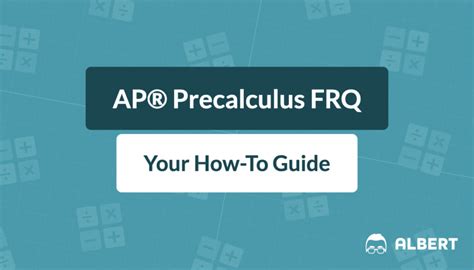Introduction
The Advanced Placement (AP) Calculus FRQ (Free Response Questions) are a crucial component of the AP Calculus exam. These questions require students to demonstrate a deep understanding of calculus concepts and their applications. To excel on the FRQ, it’s essential to adopt a strategic approach and develop a strong foundation in the subject matter.

Understanding the FRQ Format
The FRQ section of the AP Calculus exam consists of six questions, each worth 10 points. The questions are divided into two parts:
- Part A: Multiple-choice questions that test basic calculus concepts and problem-solving skills.
- Part B: Essay questions that require students to clearly and concisely explain their solutions, showing their work and logical reasoning.
Step-by-Step Approach to Tackling the FRQ
1. Read the Question Carefully
- Take the time to thoroughly read the question and identify the main concepts being tested.
- Underline key words and phrases that provide clues about the solution.
2. Identify Relevant Concepts
- Recall the relevant calculus theorems, formulas, and techniques that apply to the question.
- Relate the problem to similar examples or applications discussed in class or the textbook.
3. Plan Your Solution
- Outline a logical approach to solving the problem.
- Determine which calculus techniques to use and how to structure your response.
4. Solve the Problem Carefully
- Show all your work and explain your reasoning step-by-step.
- Use precise mathematical notation and accurate terminology.
- Check your solution for any errors.
5. Write Clearly and Convincingly
- Organize your response into a clear and coherent format.
- Use complete sentences and proper grammar.
- Provide sufficient justification and explanation for each step.
Common FRQ Topics
The FRQ covers a wide range of calculus concepts, including:
- Limits and Continuity: Evaluating limits, identifying discontinuities, and investigating the continuity of functions.
- Differentiation: Finding derivatives, interpreting their meaning, and applying them to optimization problems.
- Integration: Calculating integrals, evaluating definite and indefinite integrals, and using them to find areas, volumes, and other quantities.
- Applications of Calculus: Solving related rates problems, optimizing functions, and modeling real-world scenarios using calculus.
Tips for Success
- Practice Regularly: Solve as many FRQ-style problems as possible to develop fluency and improve your problem-solving skills.
- Review the FRQ Scoring Rubric: Familiarize yourself with the criteria used to grade the FRQ to understand the expectations and improve your writing.
- Time Management: Allocate your time wisely during the exam, ensuring you have sufficient time to complete all the questions thoroughly.
- Use Technology Wisely: Calculators and graphing tools can be helpful, but they should not be used as a substitute for understanding the concepts being tested.
- Seek Help When Needed: Don’t hesitate to ask your teacher or a tutor for assistance if you encounter difficulties or have questions about specific concepts.
Applications of Calculus in the Real World
Calculus has countless applications in various fields, including:
- Physics: Describing motion, velocity, and acceleration.
- Engineering: Designing bridges, buildings, and other structures.
- Biology: Modeling population growth, enzyme kinetics, and drug absorption.
- Economics: Optimizing production levels, analyzing market trends, and forecasting demand.
Conclusion
Mastering the AP Calculus FRQ requires a comprehensive understanding of calculus concepts, problem-solving abilities, and clear writing skills. By adopting a strategic approach, practicing regularly, and seeking support when needed, you can build the confidence and knowledge necessary to excel on the exam. Remember to apply the knowledge gained through calculus to solve real-world problems and make meaningful contributions to various fields.
Key Statistics
- According to the College Board, the average score on the AP Calculus FRQ section is around 60% each year.
- Students who score a 5 on the AP Calculus exam are more likely to succeed in college-level calculus courses.
-Calculus is used in over 90% of science, technology, engineering, and mathematics (STEM) fields.
Table 1: Common FRQ Problem Types and Solutions
| Problem Type | Solution | Example |
|---|---|---|
| Limit evaluation | Use appropriate limit laws and techniques | Evaluate lim (x->2) (x^2 – 4) / (x – 2) |
| Derivative calculation | Apply differentiation rules and formulas | Find the derivative of f(x) = sin(x)cos(x) |
| Integral evaluation | Use integration techniques and integrals | Evaluate the integral of ∫(x^2 + 1) dx |
| Optimization problem | Apply the first and second derivative tests | Find the maximum and minimum values of f(x) = x^3 – 3x^2 + 2 |
Table 2: FRQ Problem Solving Techniques
| Technique | Description |
|---|---|
| Direct substitution | Plugging in values into expressions to evaluate limits or derivatives |
| Chain rule | Using the chain rule to evaluate derivatives of composite functions |
| U-substitution | Transforming integrals to make integration easier |
| Partial fractions | Decomposing rational expressions into simpler fractions to evaluate integrals |
Table 3: FRQ Writing Tips
| Tip | Explanation |
|---|---|
| Use precise mathematical notation | Write equations, inequalities, and other mathematical expressions clearly and accurately |
| Justify each step | Explain the reasoning behind your calculations and conclusions |
| Organize your response | Present your solution in a logical and coherent format |
| Use complete sentences | Write in complete sentences with proper grammar and punctuation |
Table 4: FRQ Applications in Science and Engineering
| Field | Application |
|---|---|
| Physics | Modeling projectile motion, analyzing harmonic motion, and calculating work and energy |
| Engineering | Designing bridges with optimal strength-to-weight ratios, analyzing fluid flow in pipelines, and optimizing machine efficiency |
